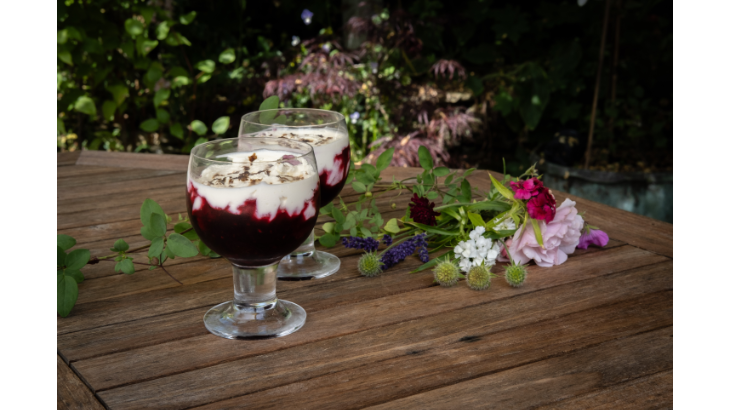Penny’s Blackcurrant Surprise Pudding

What’s for afters? This childhood refrain frequently rang round the table as the family polished off our first course. It was either “afters” or “pud”, never “sweet” or “dessert”, so I make no apologies for calling the following dish a pudding, though in the strictest terms pudding should be either baked or boiled.
I needed a gluten-free alternative to Summer Pudding, which relies on the absorbent nature of white bread, a quality that standard white sliced does not share with its gluten-free alternative, and this lovely summer fruit pudding, is it, albeit minus the strawberries.
My first iteration of this dish called for tinned blackcurrant pie filling, available in most supermarkets until about 10 years ago. Today it is not easy to source blackcurrants, but at this time of year they are more easily found. You could, if you have a neighbour with two or three blackcurrant bushes, be specially nice to them, or why not grow a couple of bushes in extra-large pots, or on the edge of your vegetable plot. Because they are one of my very favourite fruit, we have sacrificed space that could have been usefully occupied by runner beans but the blackcurrants won the tussle, and every year I freeze a large proportion of the fruit, for use in the darkest days around Christmas and New Year. Cheek by jowl with the frozen blackcurrants I recently discovered a box of raspberries, and this being a sufficient prompt, prepared this deliciously perfumed pudding.
All you will need is a quantity (about 600 grams) of blackcurrants, about 350 grams of raspberries, granulated sugar, a small pot of natural yogourt, double cream and a small amount of soft dark brown sugar.
Put the blackcurrants in a thick bottomed stainless steel or enamelled pan with half a tablespoon of water, and bring very slowly to simmering point. Add granulated sugar to taste, and stir in to distribute it with the currants. Most of the juice in the pan will be released from the fruit, and the objective is to cook the currants but not reduce them to a mush, so allow the pan to come very gently to the boil and adjust the sweetness at this point. Once the currants are just soft and starting to implode, they are cooked.
Remove from heat immediately and allow to cool. Check that there is just enough liquid in them to allow them to be stirred easily with a metal spoon, and again, check for sweetness. Blackcurrants are very high in pectin, and if there seems insufficient runniness in the cooked fruit, add another half tablespoon of boiling water. If you deem the fruit a little tart, it is better to add caster sugar if needed, which will dissolve more easily than granulated. Once the mixture has cooled, stir in the raspberries and refrigerate.
Prepare the topping by whipping the cream lightly, just enough that the whisk leaves a trail through it. Now stir in the yoghourt, which will thicken the mix. The yoghourt gives the creamy mixture a satisfying tang, which complements the richness of the fruit very nicely.
Divide the fruit concoction between dishes and carefully spoon the yoghourt cream mix onto it – a little like making an Irish coffee, although the topping will not pour satisfactorily, hence the need to spoon it. Finally, using your finger and thumb, sprinkle small patches of brown sugar over the top – you’re looking to form an archipelago of sugar, not a landmass, so hold back on the quantity.
Finally, cover the dish or dishes, preferably with beeswax wrap, and chill till you’re ready to serve. Bon appetit.
The precursor to this recipe was given to me in the 1980s by my friend Penny Pierce, hence its somewhat quirky name.
